
Edison Catalog
|
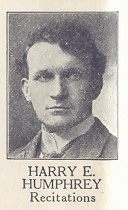
Edison Catalog
|
Edna Bailey
Harry
Humphrey 1873-1947
The most prominent
performer of spoken word recordings on Edison cylinders was elocutionist
Harry E. Humphrey. Featured on
Cyberbee are recordings
he made of poetry recitations and monologues of famous speeches,
including ones by James Whitcomb Riley, Abraham Lincoln, Patrick
Henry, and George Washington. Edna Bailey is featured telling
bedtime stories, The Three Bears and Chicken Little.
Reference
Spoken
Word on Edison Diamond Discs (1912-1929). Edison Sound
Recordings
The National Phonograph Co. and Thomas A. Edison, Inc. American
Memory Collections at the Library of Congress. |
|
George Washington Johnson
October 1846 – January 23, 1914
|
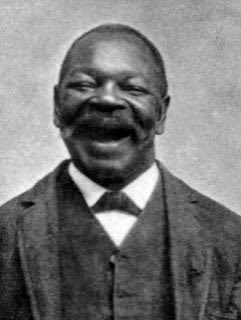
George W. Johnson (Cover of The Laughing Song)
Courtesy of the Library of Congress

The Laughing Song Edison Records
Courtesy of the University of California, Santa Barbara Library
|
Born a slave, George W. Johnson became the first African American recording artist in 1890. His tune, The Laughing Song was a huge hit. By 1895, Johnson's tunes were the best-selling recordings in the United States. The total sales of his wax cylinders between 1890 and 1895 are estimated to have been at 25,000 to 50,000, each one recorded individually by Johnson. He continued recording throughout the 1890s and eventually was recorded by Berliner, Edison, and Columbia.
Warning: Historical recordings may contain offensive language. This selection is presented as part of the record of the past. It is an historical document which reflects the attitudes, perspectives, and beliefs of different times. Cyberbee does not endorse the views expressed in this recording, which may contain content offensive to users.
References
African American Performers on Early Sound Recordings, 1892-1916 [article]The Library of Congress
Television and Record Industry History Resource by Tim Brooks
Wikipedia |
|

Edison Catalog
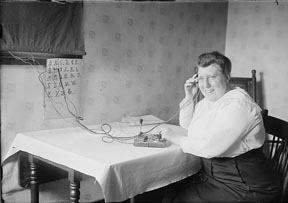
Ada Jones
George Grantham Bain Collection (Library of Congress)
|
Ada Jones
June
1, 1873 – May 2, 1922
The first woman
to achieve widespread acclaim as a professional recording star
was Ada Jones (1873-1922) who was called “the first lady
of the phonograph.” With her clear, strong voice and excellent
diction, Jones was one of the first women to successfully record
on commercial cylinders and discs. Her repertoire included dialect
sketches, conversational duets, and comic songs. Jones was born
in Lancashire England in 1873 and in 1879 traveled with her family
to Philadelphia, Pennsylvania. Ada’s earliest stage performances
were in juvenile roles in the 1880s and a brief recording stint
with the North American Phonograph Company until their demise.
In 1905, Edison and Victor both released titles by Jones. She recorded
a number of duets with Billy Murray and Len Spencer. Her popularity
declined when jazz took center stage. Ada Jones died of kidney
failure in 1922. She was survived by her husband Hugh Flaherty
and one daughter.
Reference
Sutton, Allan. A Pre-history
of Ada Jones: 1889- 1905. Denver: Mainspring Press,
2000.
The Songwriters
Hall of Fame
Spoken
Comedy on Edison Diamond Discs (1912-1929). Edison Sound
Recordings The National
Phonograph Co. and Thomas A. Edison, Inc. American Memory Collections
at the Library of Congress.
|
|
Christine Miller
1885
- July 5, 1956
Christine Miller
was regarded as one of the most important concert singers in the
United States. She performed in many concert tours. In several
venues she demonstrated tone tests to promote Edison disc recordings.
Miss
Christine Miller, the noted concert contralto, demonstrated in
a recital at Symphony Hall, Boston, how thoroughly Edison has
made it possible to reproduce all shades of tone and sweetness
of the human voice. Miss Miller, standing beside one of the phonographs,
singing in unison with herself, it being impossible to distinguish
between the singer's living voice and its re-creation. She sang
a few bars and the instrument blended perfectly with her voice.
She ceased and the instrument continued the air with the same
beautiful tonal quality.
Miller recorded
songs until 1918 when she married Pittsburgh steel manufacturer,
Daniel M. Clemson.
Refrence
Edison Advertisement.
Farm Journal, Vol. 42 May, 1918, p. 280.
Edison Advertisement.
The Milwaukee Journal, December 2, 1915, p.9.
|
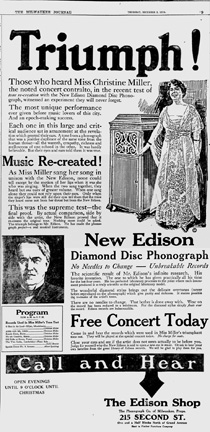
Click to view
larger image
Edison Advertisement
The Milwaukee Journal, December 2, 1915, p.9
|
|

Edison Catalog
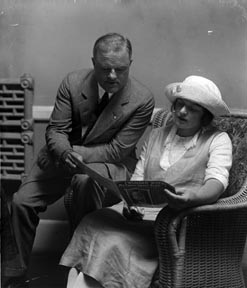
Billy Murray & Ailleen
Stanley
George Grantham Bain Collection (Library of Congress)
|
Billy
Murray
May 15, 1877 – August 17, 1954
Murray was born in Philadelphia, Pennsylvania in 1877. In 1882, at
the age of five, he moved with his parents to Denver, Colorado. During
his youth he became interested in theater and joined a vaudeville troupe.
He also performed in minstrel shows. By 1903, he was recording for
the major record companies.
Known as the Denver Nightingale, Billy Murray was one of the most popular
entertainers of his day. He was best known for his comic and novelty
songs, although he performed ballads and romantic numbers as well.
Tunes like Casey Jones, Grand Old Rag (Flag), Come Josephine in my
Flying Machine, The Little Ford Rambled Right Along, and In My Merry
Oldsmobile were big hits. He also sang duets with Ada Jones and Aileen
Stanley and was a member of several quartets.
When the technology changed from an acoustic recording
horn to the electric microphone in the 1920s, his “hammering” style
of singing didn’t work as well. Although, he was less in
demand, Murray continued to record, did voices for animated cartoons,
and
worked in radio. He died of a heart attack in 1954. He was married
three times.
The first two ended in divorce. He was survived by his third
wife, Madeleine.
References
Billy
Murray (singer), Wikipedia
The Official
Website of Billy Murray |
|
Geoffrey
O’Hara
February
2, 1882 – January 31, 1967
Canadian-born
Geoffrey O’Hara was a composer, singer, music professor,
and ethnomusicologist. He moved to the United States in 1904 and began
recording for Edison Records in 1905. In 1913, he was appointed by
the Secretary of the Interior to be an instructor of native music.
He collected and recorded songs of the Navajo Indians on wax cylinders.
O’Hara sang several of the Navajo songs on a 1914 Edison cylinder
titled, Navajo Indian Songs. Theodore Roosevelt had this to say about
O’Hara in A Book-Lover’s Holidays in the Open published
in 1916.
Among the others at the snake-dance was Geoffrey O'Hara, whom
Secretary of the Interior Lane has wisely appointed instructor
of native Indian
music. Mr. O'Hara's
purpose is to perpetuate and develop the wealth of Indian music and poetry—and
ultimately the rhythmical dancing that goes with the music and poetry. The Indian
children already know most of the poetry, with its peculiarly baffling rhythm.
Mr. O'Hara wishes to appoint special Indian instructors of this music, carefully
chosen, in the schools; as he said: "If the Navajo can bring with him into
civilization the ability to preserve his striking and bewildering rhythm, he
will have done in music what Thorpe, the Olympic champion, did in athletics." Miss
Curtis and Mr. O'Hara represent the effort to perpetuate Indian art in
the life of the Indian to-day, not only for his sake, but for our own.
This side
of Indian
life is entirely unrevealed to most white men; and there is urgent need
from the standpoint of the white man himself of a proper appreciation of
native
art. Such appreciation may mean much toward helping the development of
an original American art for our whole people.
He married Constance
Dougherty in 1919, the same year he became a naturalized American
citizen. They had two children. O’Hara went on to teach at the
Teachers’ College Columbia University (1936-37), Huron College, and the
University of South Dakota where he received an honorary Doctor of Music degree
in 1947. His biggest hit was K-K-K-Katy written in 1918. O’Hara
was also a popular lecturer until his death in 1967.
References
Geoffrey O'Hara, composer, singer and lecturer (1882-1967. The
Virtual Gramophone: Canadian Historical Sound Recordings.
Gracyk,
Tim, Cooper, B. Lee, and Hoffman, Frank. Popular American recording
pioneers, 1895–1925. Binghamton, New York: Haworth Publishing,
Inc., 2000.
Roosevelt,
Theodore. A Book-Lover’s Holidays in the Open. New York:
Charles Scribner’s Sons, 1916. |
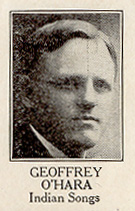
Edison Catalog
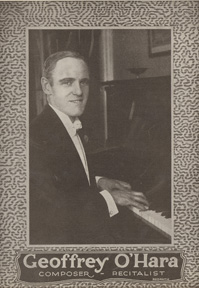
Courtesy of The Library of Congress
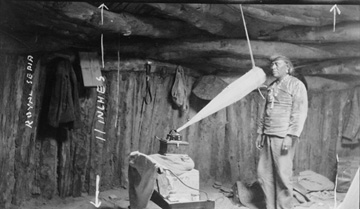
Miguelito making
phonograph record
Copyright by Geoffrey O'Hara, New York, N.Y.
Library of Congress Prints and Photographs Division
|
|
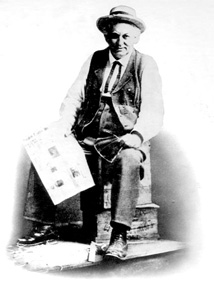 Cal Stewart, Circa
1900. Photographer unknown.
Cal Stewart, Circa
1900. Photographer unknown. |
Cal Stewart
1856 – December 7, 1919
Cal Stewart was known for his comic monologues as
Josh Weathersby who lived in an imaginary New England town, Punkin’ Center.
The stories featured rural humor that focused on topical
events such as Groundhog
Day at Pumpkin Center or modern life such as Uncle Josh in a Photograph
Gallery. His boisterous laugh at the beginning and end of the recordings
was a Cal Stewart signature. Cal Stewart’s wife, Rossini
Waugh Stewart, played Aunt Nancy on the early Uncle Josh recordings.
Later,
Ada Jones, assumed that role. Cal Stewart died from a brain tumor
in 1919 and his wife died in 1943.
References
Gracyk, Tim,
Cooper, B. Lee, and Hoffman, Frank. Popular American recording
pioneers, 1895–1925. Binghamton, New York: Haworth
Publishing, Inc., 2000.
Spoken
Comedy on Edison Diamond Discs (1912-1929). Edison Sound
Recordings
The National Phonograph Co. and Thomas A. Edison, Inc. American Memory
Collections at the Library of Congress.
|

|
|













